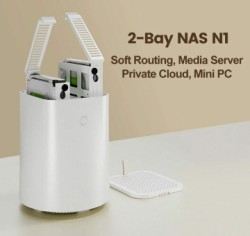Linux-Centric Devices and Open Hardware
-
Topton N1 dual-bay NAS features AMD Athlon 3050e CPU, four Ethernet ports - CNX Software
Powered by an AMD Athlon Silver 3050e dual-core processor, Topton N1 (aka TP-N1) NAS comes with two SATA bays for 2.5-inch or 3.5-inch drives, as well as four gigabit Ethernet ports.
The system can support up to 32GB RAM, relies on M.2 SSD storage for the OS, and can provide up to 40TB of data storage through the two SATA bays. It is also equipped with an HDMI output port, several USB 3.x/2.0 ports, as well as a 3.5mm audio jack.
-
ESP32-S3 development board integrates OV2640 camera and mPCIe slot
LILIGO’s T-SIMCAM is a development board featuring the ESP32-S3 System on Chip (SoC) enabled with Wi-Fi and BLE support. Additionally, this compact board features the OV2640 camera module, a SIM card slot and a mPCIe slot for T-PCIE SIM modules.
The SoC found on the T-SIMCAM is the ESP32-S3R8 which features a dual-core LX7 Tensilica microprocessor with a maximum frequency of 240MHz. The T-SIMCAM also includes 16MB of Flash storage and up to 8MB of PSRAM.
-
Is Arduino a Microcontroller
Arduino is a hardware and software programming platform based upon Atmel ATmega microcontrollers. It is an open-source platform which means all the codes and libraries are openly available and easy to modify by students, beginners, and experts in the Arduino community. Arduino is popular among people as it doesn’t need any external hardware for programming. It is a development board based upon microcontroller and easy to program by just using USB cable.
-
The first time we encountered law enforcement malware
Mikko Hyppönen is a security expert and author. In an excerpt from his new book “If It’s Smart, It’s Vulnerable” he writes about government malware and the techniques of law enforcers. He also reveals how he learnt about German law enforcement malware and how the Chaos Computer Club made sure that everybody could detect it.
-
Rooting a Hikvision Indoor Station to set a static IP address
Recently, I’ve been tinkering with a Hikvision surveillance system which includes an Android Indoor Station aptly named DS-KH9510-WTE1. Whilst this runs Android behind the scenes, it exposes a custom UI made by Hikvision that completely hides the standard Android screens and menus.
-
What the KIM-1 really needs is bubble memory (plus: 20mA current loop for fun and profit)
It seems like everything has flash. Flash mobs, flash photography, Flash Gordon, flash memory. (Other than the past couple years, of course, which haven't been very flash.) And, because solid-state-all-the-things, you can get flash storage devices for tons of classic computers where even the tiny microcontroller in the SD cards is probably more powerful than the systems they're being interfaced to. Why, you can even connect one to an MOS KIM-1, the famous mid-1970s MOS 6502 single-board computer. Now at last you don't need to rekey everything in or screw around with an audio recorder.

